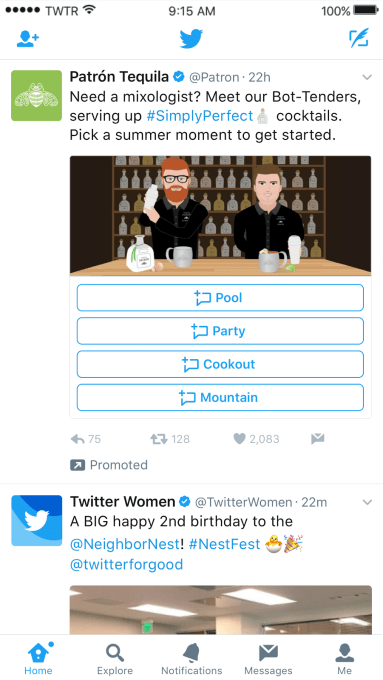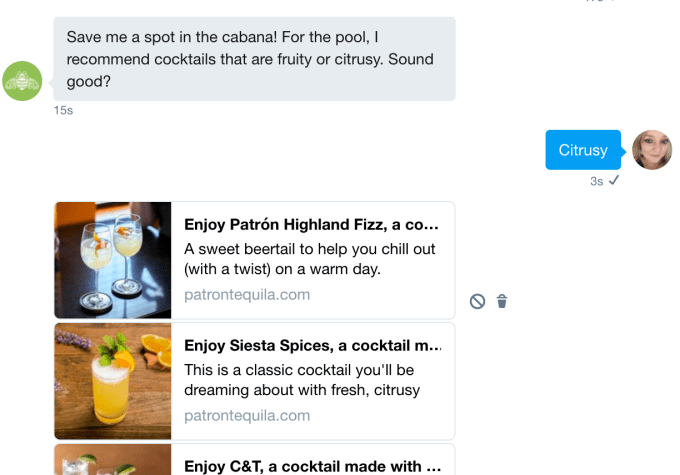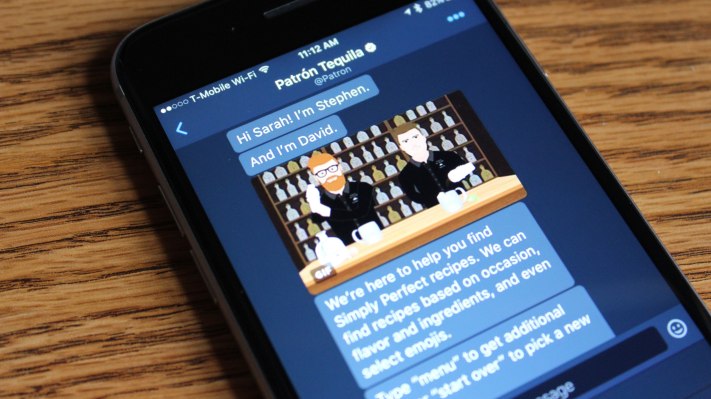Twitter has found its own way to participate in the growing chatbot trend. The company announced today a new feature for advertisers, which allows businesses on Twitter to promote ads designed to pull consumers into personalized experiences within Direct Messaging – including interactions with chatbots. For example, one brand is running a bot that can help you with a cocktail recommendation after you provide answers to questions about occasion or flavor. These interactions get started via a promoted “Direct Message Card,” as the new, customizable card for businesses is called.
The cocktail bot – “Bot-Tender” – comes from spirits brand Patrón Tequila, which is kicking off the launch of Twitter’s new feature with its own Promoted Tweet campaign using the new card style.

The Direct Message Card can be customized using either an image or video and up to four call-to-action buttons meant to encourage Twitter users to slide into a brand’s DMs. (I’m sorry.)
The cards are not about pushing people to bots that help solve customer service issues or encourage purchases from the brand in question, as is the focus of many Facebook chatbots. Instead, they’re about getting people to interact with the brand through a private messaging experience that’s meant to be fun, not transactional.
Another example where the card could be used – though it has since passed – was the March Madness bracket builder that Wendy’s launched earlier this year. In this case, an automated experience let fans create their brackets via DM, then revisit them throughout the tournament to see how they did as well as win prizes.
Businesses taking advantage of the new format can also prompt consumers to reshare the experience through a tweet prompt, following their interaction with the bot in question.

Whether or not consumers will actively embrace bots at scale still remains to be seen.
Many of the early attempts in this space have fallen short of consumer expectations. Facebook’s first chatbots, for instance, annoyed people by pretending to be a person – leaving customers feeling like they were interacting with the messaging-based version of a call center’s phone menu. And their shopping or information-sharing experiences were often not any easier than visiting the business’s own website.
Despite chatbots’ uncertain future, many companies have invested in this space. Microsoft unveiled a bot framework and chatbots for Skype last year, and more recently added support for chatbots to LinkedIn; messaging apps beyond Facebook’s Messenger are also adding bots, as with Telegram’s newly added support for shopping bots; and Google is making a play for the backend of the chatbot space, with its chatbot analytics platform, Chatbase.
Twitter – though home to many auto-tweeting bots – seems to be just testing the waters with chatbots, to see if it’s something brands will want to adopt and want to then promote through Twitter ads.
The company’s earlier efforts in terms of brands and their DMs have instead focused more on the bigger business of customer support interactions. The company has rolled out features like welcome messages, quick replies, custom profiles, location sharing, and other tools that let businesses augment their customer support interactions with automation. But things like a welcome message or quick reply aren’t really considered bots.
The new Direct Message Cards are launching now into beta, and are only open to Twitter advertisers.
